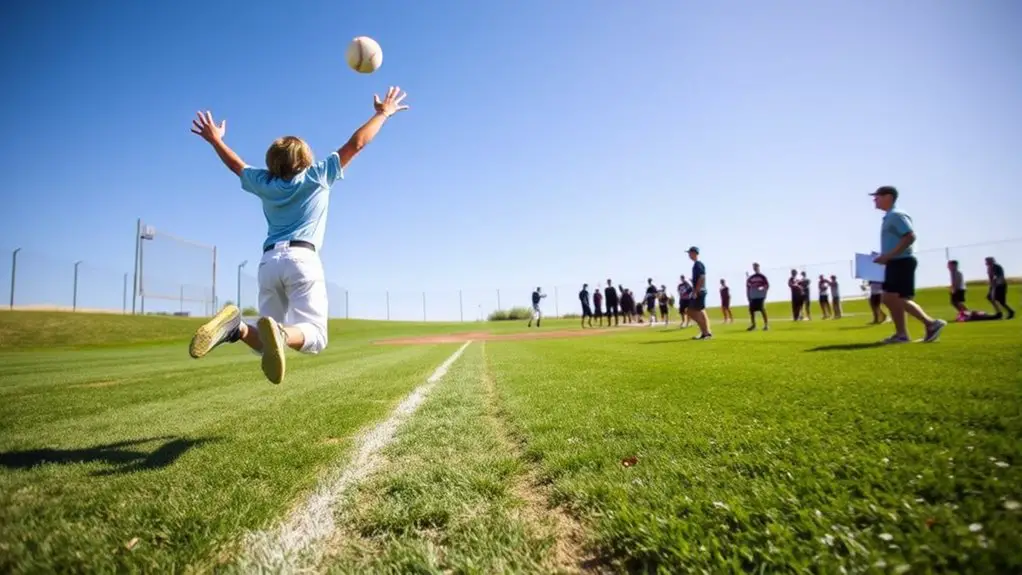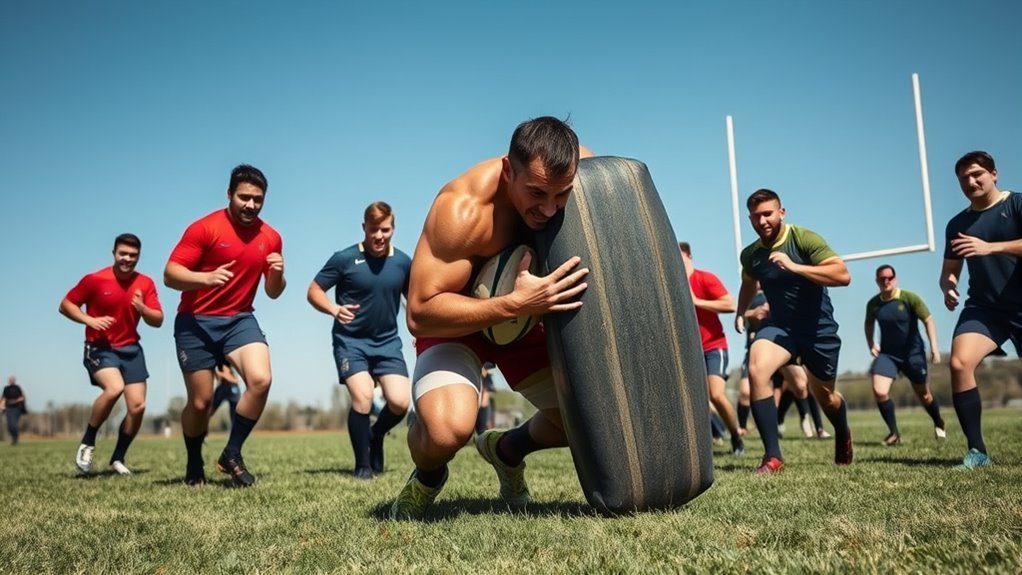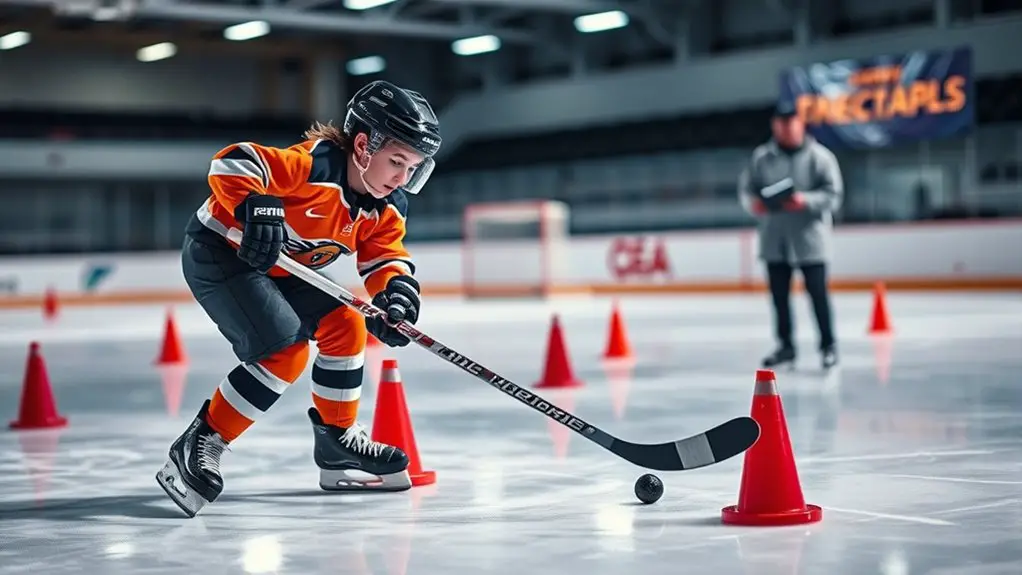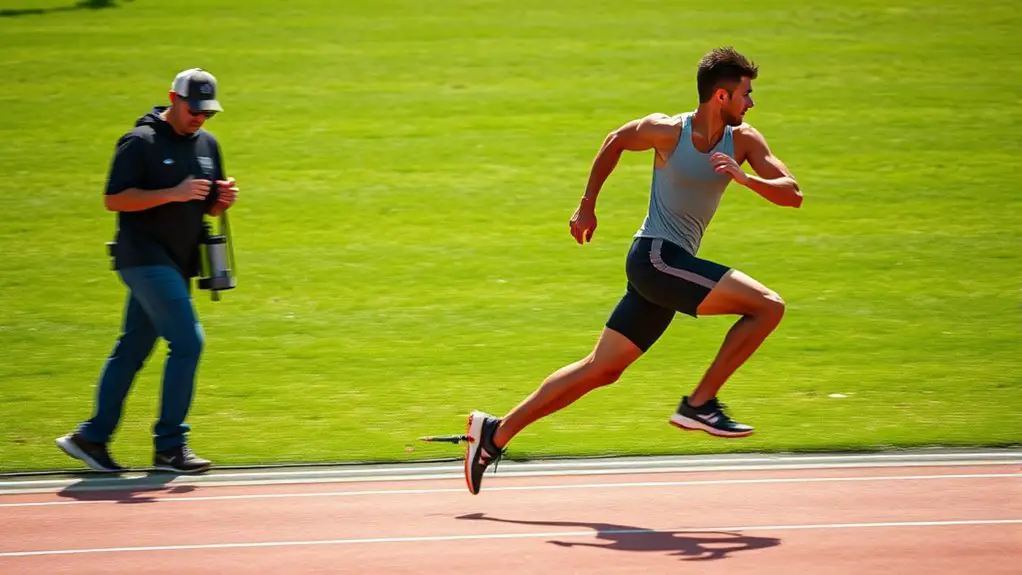To become a better outfielder, you need to focus on tracking drills for fly balls. Start with basic drills like partner tosses and the bucket drill to sharpen your skills. As you progress, incorporate advanced techniques like visualization and maintaining a low center of gravity. Don't forget to practice with a partner to enhance your reaction time. Finally, consider using technology for real-time feedback on your performance. Discover more about perfecting your catching technique next!
The Importance of Tracking Drills for Outfielders
When it comes to excelling in the outfield, tracking drills are essential because they sharpen your ability to judge and react to fly balls. These drills enhance your outfield positioning by helping you anticipate the ball's trajectory, allowing you to move freely and confidently. You'll develop a keen sense of where to be, making those challenging catches feel effortless.
Effective fly ball communication is also vital. You need to know when to call for the ball and when to defer to a teammate. Practicing tracking drills will improve not only your catching skills but also how well you interact with your fellow outfielders. By honing your instincts and reactions, you're setting yourself up for success in those game-time moments. When you master these aspects, you'll feel the thrill of freedom on the field, knowing you're ready for any challenge that comes your way.
Basic Fly Ball Drills to Start With
To build a solid foundation in outfield play, starting with basic fly ball drills is essential. These drills will help you develop your basic catching skills and boost your confidence under high-pressure situations. Here are three drills to kick things off:
Building a solid foundation in outfield play begins with essential fly ball drills to enhance your catching skills and confidence.
- Partner Toss: Have a partner toss the ball high in the air while you focus on tracking it. This helps you get used to moving towards the ball.
- Bucket Drill: Place a bucket or cone at your position. As a coach or teammate throws fly balls, you should aim to catch them while moving toward the bucket, enhancing your footwork.
- Backpedal Drill: Start facing away from the thrower. When you hear "go," backpedal while keeping your eye on the ball, allowing you to practice adjusting your position.
These drills are a great way to get started on your journey to mastering the fly ball!
Advanced Tracking Techniques for Experienced Players
As you progress in your outfield skills, mastering advanced tracking techniques becomes essential for making those game-changing catches. Visualization techniques play a vital role here; before the pitch, picture the ball's trajectory and where you'll need to be. This mental rehearsal helps you react instinctively when the ball is hit.
Next, focus on your body positioning. Always maintain a low center of gravity and stay balanced as you track the ball. You want to be agile, ready to adjust your stance based on the ball's direction. Using quick, short steps can help you navigate the field more effectively, allowing you to cover ground swiftly.
Lastly, don't forget to keep your eyes on the ball at all times. Combining these visualization techniques with proper body positioning can elevate your outfield game, turning you into an indispensable asset for your team.
Partner Drills for Enhanced Reaction Time
While improving your reaction time is essential for outfield success, partner drills can provide the perfect opportunity to sharpen those skills. These partner exercises not only enhance your agility but also make training enjoyable. Here are a few effective reaction drills you can try with a buddy:
- Quick Toss Drill: Stand a few feet apart and toss the ball back and forth. Gradually increase the speed and unpredictability of your throws.
- Shadowing: One partner moves in various directions while the other mimics their movements. This builds quick reflexes and enhances your ability to read the play.
- Reaction Box: Create a small area where one partner randomly calls out directions (left, right, forward, backward). The other must react instantly, catching a ball thrown in that direction.
Incorporating these drills into your routine will boost your reaction time and confidence on the field. Additionally, practicing mental conditioning techniques will further enhance your ability to respond swiftly and accurately in game situations. Enjoy the freedom of movement and let your instincts take over!
Incorporating Technology Into Tracking Drills
Improving reaction times with partner drills sets a solid foundation for outfield performance, but integrating technology can take your training to the next level. By incorporating video analysis, you can break down your movements and identify areas for improvement. Watching yourself in action helps pinpoint exactly what you need to work on, allowing for targeted drills that enhance your skills.
Additionally, wearable technology, like smartwatches or motion sensors, can track your performance metrics in real-time. These devices can measure your speed, reaction time, and even your positioning relative to the ball. The data they provide empowers you to make informed adjustments during practice. Wearable fitness trackers can also provide real-time heart rate monitoring, enhancing your training effectiveness.
Embrace these tools, and you'll not only refine your tracking abilities but also gain a deeper understanding of your strengths and weaknesses. Combining traditional drills with cutting-edge technology gives you the freedom to elevate your game and become a more confident outfielder.
Tips for Perfecting Your Catching Technique
To catch effectively, you need to focus on a few key techniques that can greatly enhance your performance on the field. Mastering these aspects will boost your confidence and elevate your game:
- Catching Posture: Keep your knees slightly bent and your feet shoulder-width apart. This stance allows for quick movement in any direction.
- Glove Positioning: Always keep your glove open and ready, angling it slightly upward to cradle the ball. This helps in securing the catch smoothly.
- Eyes on the Ball: Maintain focus on the ball from the moment it's hit until it lands in your glove. This mental commitment is essential for successful catches.
Frequently Asked Questions
What Age Should Players Start Practicing Outfield Tracking Drills?
Imagine a young bird learning to soar through the sky; that's how you should think about youth development in baseball. You can start practicing outfield tracking drills as early as age 8. This early exposure aids in skill progression, allowing players to build confidence and technique. With each drill, you're giving them the freedom to explore their potential, transforming them into adept outfielders ready to chase any fly ball that comes their way.
How Can Weather Conditions Affect Fly Ball Tracking Drills?
Weather conditions can really impact your fly ball tracking drills. If it's windy, you'll notice the ball's path can change unexpectedly, making it tricky to judge. On sunny days, the glare might blind you, so you'll need to adjust your focus. Embracing these elements can enhance your skills; it's all about adapting and overcoming challenges. So, don't shy away from practicing in different conditions, as they'll make you a more versatile player.
Are There Specific Shoes Recommended for Outfield Drills?
When you're choosing shoes for outfield drills, consider cleat types that offer the best traction. You want footwear that helps you maintain your footing while sprinting and changing directions. Turf shoes can work well on artificial surfaces, while molded or detachable cleats are great for grass. The right traction is essential for quick movements, allowing you to track fly balls effectively. Don't underestimate how the right shoes can enhance your performance and freedom on the field!
How Often Should Players Practice Tracking Drills Each Week?
Like a bird soaring through the sky, you need to spread your wings with practice consistency. Aim for at least three to four times a week when it comes to tracking drills; frequency recommendations suggest this will sharpen your instincts and elevate your skills. Each session is a chance to break free and embrace the thrill of the game, allowing you to glide effortlessly under those fly balls. So, take to the field and practice!
Can Tracking Drills Help With Catching Ground Balls Too?
Tracking drills primarily focus on improving your tracking accuracy for fly balls, but they can indirectly benefit your ground ball techniques too. By enhancing your overall awareness and footwork, you'll find it easier to adjust to grounders. While the drills may not target ground balls specifically, the skills you develop can translate into better reactions and positioning when fielding. So, practicing tracking drills can definitely enhance your game in more ways than one!




